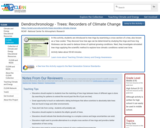
In this activity, students develop an understanding of the relationship between natural phenomena, weather, and climate change: the study known as phenology. In addition, they learn how cultural events are tied to the timing of seasonal events. Students brainstorm annual natural phenomena that are tied to seasonal weather changes. Next, they receive information regarding the Japanese springtime festival of Hanami, celebrating the appearance of cherry blossoms. Students plot and interpret average bloom date data from over the past 1100 years.
- Subject:
- Applied Science
- Biology
- Career and Technical Education
- Environmental Science
- Environmental Studies
- Life Science
- Physical Science
- Material Type:
- Activity/Lab
- Provider:
- CLEAN: Climate Literacy and Energy Awareness Network
- Provider Set:
- CLEAN: Climate Literacy and Energy Awareness Network
- Author:
- Lisa Gardiner
- National Center for Atmospheric Research (NCAR)
- et al.
- Date Added:
- 06/19/2012


